Key takeaways:
- Inclusivity in education involves valuing every voice and fostering an environment where students’ unique experiences are heard and appreciated.
- Implementing a student-centered approach and celebrating cultural diversity through inclusive materials can enhance engagement and belonging among learners.
- Creating safe spaces for dialogue allows students to express their identities, reinforcing empathy and connection within the classroom community.
- Personal experiences with inclusivity initiatives highlight the transformative power of open conversations and creative expression in fostering understanding and compassion.
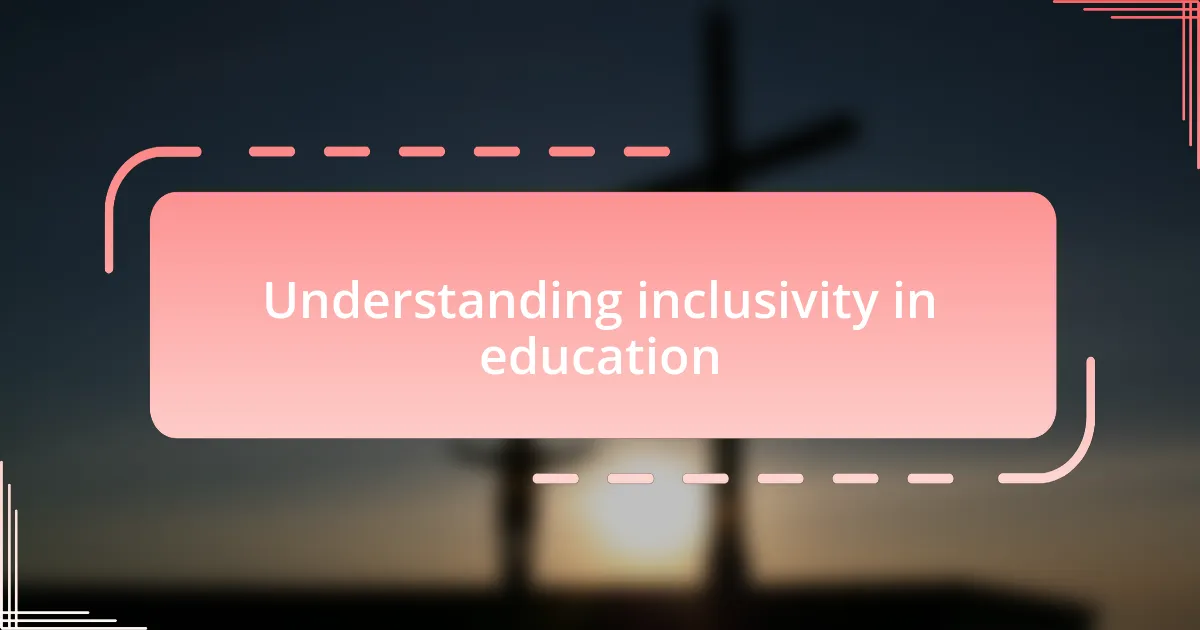
Understanding inclusivity in education
Inclusivity in education goes beyond simply accommodating diverse learners; it’s about creating an environment where every voice is valued. I remember a time when a student in my class shared his experience of feeling overlooked due to his learning style. His vulnerability sparked a meaningful conversation that made us all reconsider the importance of listening to one another.
When I think about what inclusivity truly means, I often reflect on my own classroom experiences. I once had a student from a different cultural background who felt unsure about how to contribute. I encouraged her to share her unique perspectives, and the moment she spoke up, I saw her confidence blossom. Isn’t it fascinating how one small change can cultivate an atmosphere where learners thrive?
Understanding inclusivity also means recognizing that each student’s journey is unique. I caught myself wondering: What if we actively sought to understand the stories each student brings into the classroom? By fostering dialogue about our differences and embracing them, we can empower all students to shine in their own right.
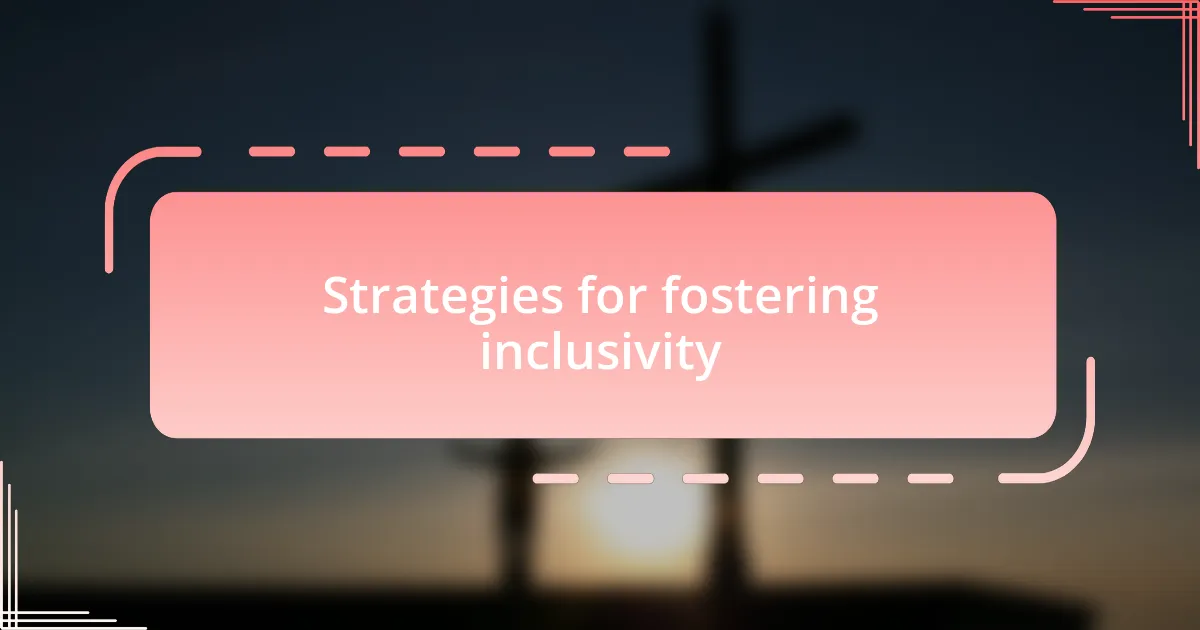
Strategies for fostering inclusivity
Adopting a student-centered approach can significantly enhance inclusivity in the classroom. I recall implementing various teaching methods tailored to different learning styles, from visual aids to hands-on activities. It was eye-opening to witness how students who initially struggled began to engage when lessons resonated with their individual preferences. Have you ever noticed how inclusion fosters a sense of belonging?
Another effective strategy is celebrating cultural diversity through inclusive curriculum materials. I remember when I introduced books and resources that reflected the histories and experiences of all students. One particular lesson, grounded in a folktale from a student’s home country, not only captured everyone’s attention but also sparked a rich dialogue among peers. How powerful it is when literature serves as a bridge between different worlds!
Moreover, creating safe spaces for open dialogue about identity and experience is crucial. In one of my classes, I organized “sharing circles” where students could express their feelings about inclusion or exclusion. Watching their peers listen attentively and validate each other’s experiences reinforced the value of empathy and connection. Isn’t it remarkable how these shared moments can transform a community?

Engaging diverse community members
Engaging diverse community members starts with genuine outreach. I remember hosting a local open house where I invited families from various backgrounds to share their stories and traditions. The excitement in their eyes as they shared unique perspectives was contagious and reminded me of the importance of listening. Have you ever thought about how much richer our understanding becomes when we truly connect with others?
Another approach that has worked for me is collaborating with community leaders and organizations. I partnered with a local cultural center to create events that celebrate our neighborhood’s diversity, such as cooking classes and art exhibits. It was inspiring to see community members from different walks of life come together, sharing their expertise and forging lasting friendships. Isn’t it fascinating how shared experiences can break down barriers and foster understanding?
Lastly, utilizing technology can be an effective way to engage diverse voices. I launched an online forum where community members could discuss topics related to inclusivity and share resources. One evening, I spent hours responding to heartfelt questions and insights from participants who had never met before. It struck me how this virtual space allowed for a safe exchange of ideas, proving that inclusivity can thrive even beyond physical boundaries. Have you experienced that sense of connection in unexpected ways?
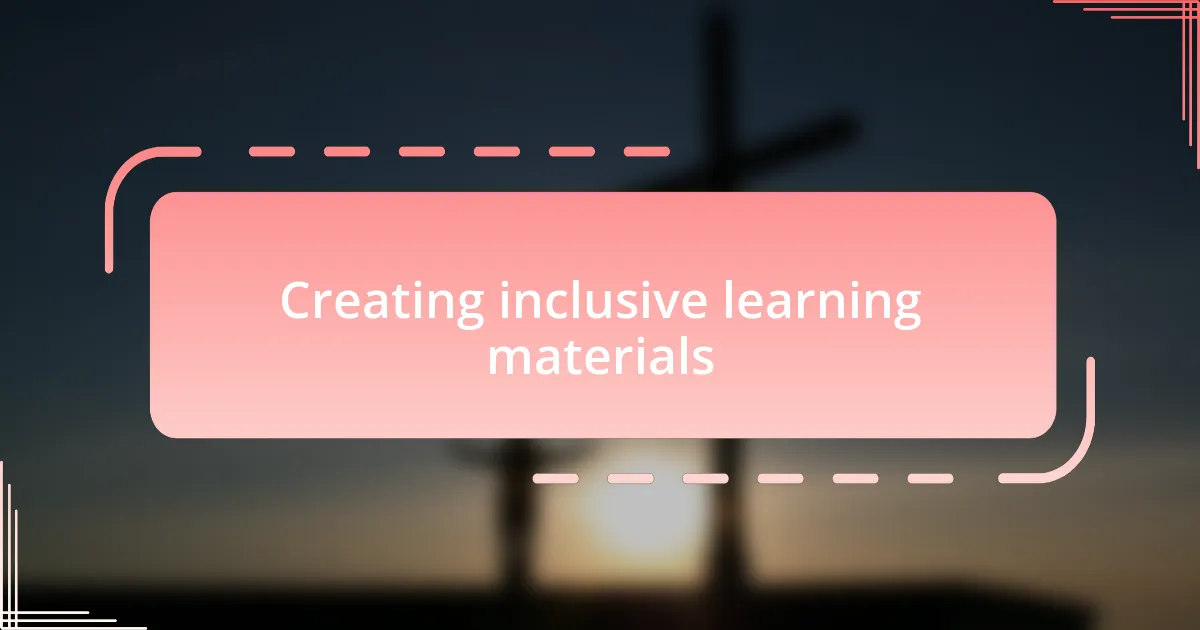
Creating inclusive learning materials
Creating inclusive learning materials requires a thoughtful approach to representation. In my experience, I always consider the varied backgrounds of my students when developing curriculum resources. For instance, I once integrated stories from different cultures into our lesson plans, allowing students to see their identities reflected in what they were learning. Didn’t you notice how powerful it feels when you can connect personally with what you’re studying?
I’ve found that offering diverse perspectives fosters critical thinking. When I include texts from a range of authors, each with unique viewpoints, it encourages discussions that I never anticipated. It’s thrilling to see students challenge one another respectfully and explore the nuances of each perspective. Isn’t it amazing how a simple change in materials can ignite a fire of curiosity in students?
Additionally, using visuals that represent various cultures and backgrounds can profoundly impact inclusivity. I recall designing a classroom display that highlighted traditions from around the world—students contributed images and descriptions of their own heritage. Watching their pride display as they shared with peers was a touching reminder of the importance of visibility. How often do we consider the impact of what we see on our sense of belonging?
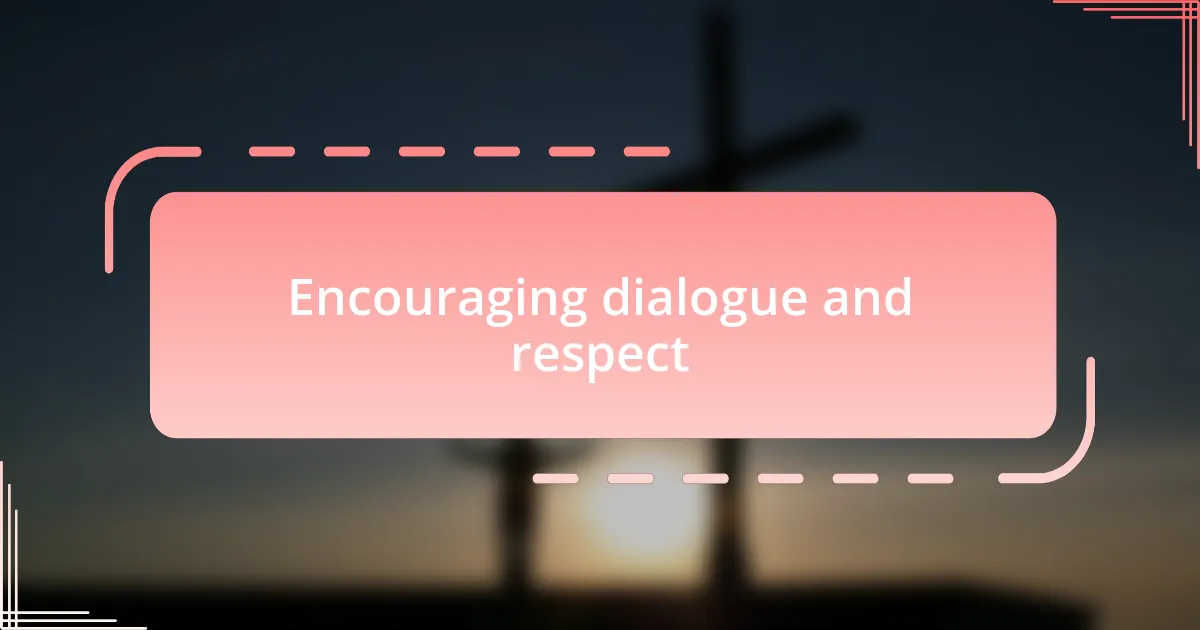
Encouraging dialogue and respect
Encouraging dialogue and respect begins with creating an environment where every voice feels valued. I remember a particular class discussion where students were encouraged to share their beliefs and experiences. The atmosphere shifted as they listened attentively to one another, fostering a sense of trust. Don’t you think it’s refreshing when people are willing to open up and respectfully challenge ideas?
I’ve also discovered the power of structured conversations, like socratic seminars. By framing discussions around open-ended questions, I’ve seen students dive deeper into each topic. One of the most memorable moments was when a shy student found her voice, sharing insights that sparked a lively debate. Isn’t it incredible how engaging with diverse perspectives can lead to deeper understanding and empathy?
In my experience, celebrating differences through respectful dialogue enriches the community. I often host roundtable discussions where we explore sensitive topics, and I’ve watched students navigate their differences with grace. The shared respect in those moments feels transformative—don’t you agree it’s heartening to witness growth in interpersonal communication?
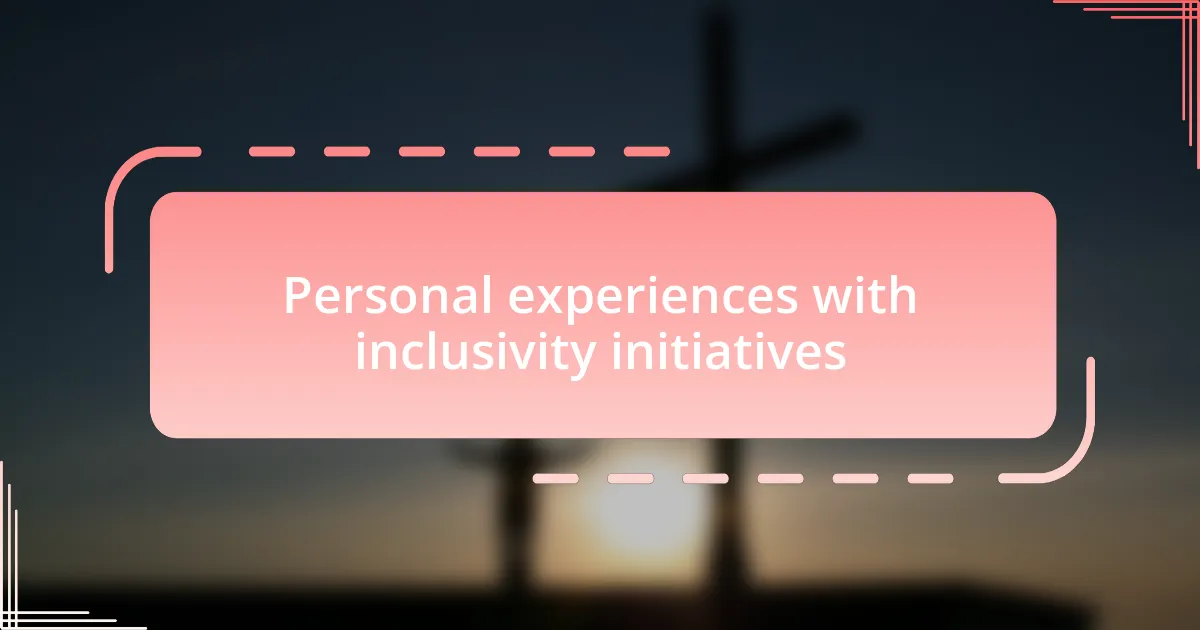
Personal experiences with inclusivity initiatives
I’ve participated in various inclusivity initiatives that have truly shaped my perspective on community engagement. One initiative that stood out was organizing interfaith dialogues at my local community center. Initially, I felt apprehensive—would the conversations be respectful? To my surprise, the warmth and curiosity from participants created a space where we could share beliefs and practices openly, fostering connections I didn’t expect. Isn’t it amazing how the simplest of gatherings can break down barriers?
Another experience that comes to mind is a workshop I led focused on the importance of + representation in religious education. As I prepared, I worried about how my insights would be received. However, the honesty and vulnerability from attendees resulted in powerful discussions about identity and acceptance. The emotional resonance during those conversations truly highlighted the need for inclusivity within our teachings. Don’t you think that when we bring these conversations to the forefront, we are not only educating ourselves but also nurturing a more compassionate community?
Reflecting on these experiences, I realize how vital it is to adapt our approaches to inclusivity. For instance, I recently embraced art as a medium for expression in a community project. Watching children and adults alike articulate their beliefs through creativity was enlightening. Each piece told a story of individuality, yet collectively, they painted a vivid picture of our diverse community. How does art change our perception of inclusivity for you? For me, it transforms dialogue from mere words to heartfelt expressions.